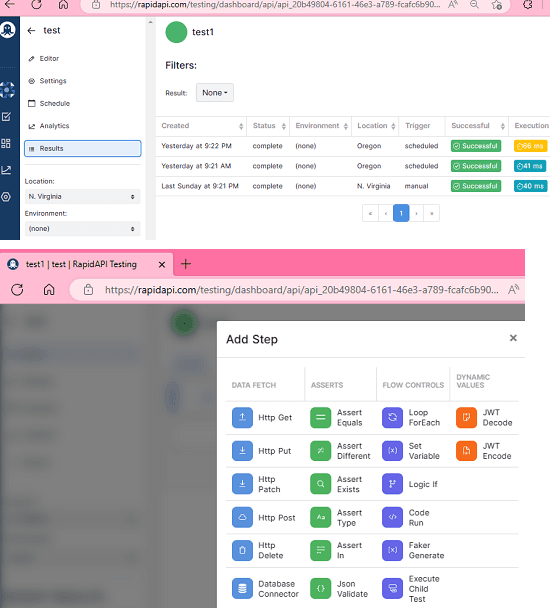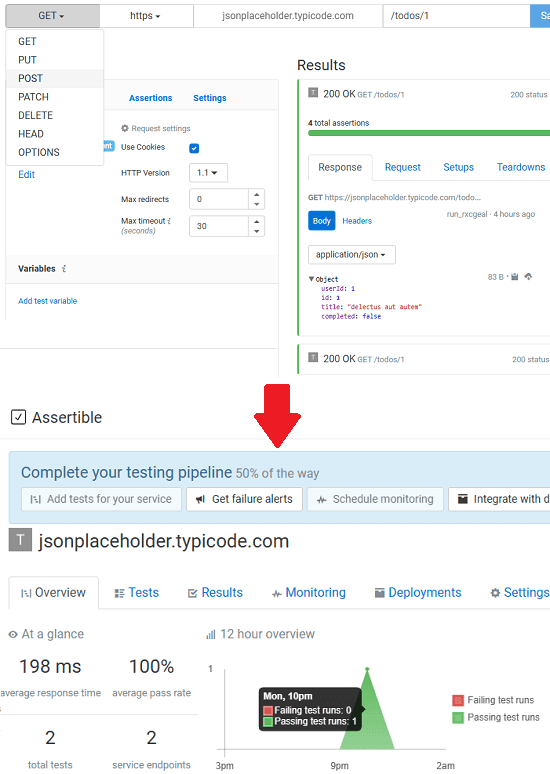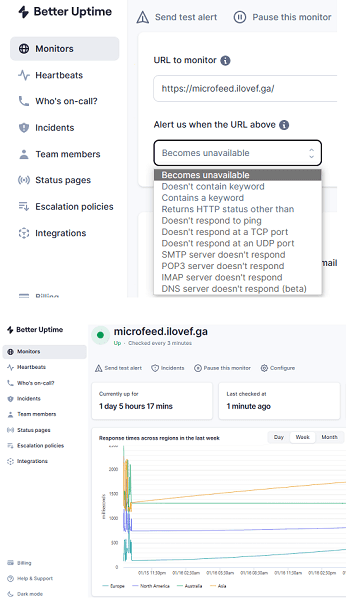This post lists some best free API uptime monitoring services that you can use. Using these, you can monitor your APIs for correct responses and their uptime. All the services I have added in this post keep checking your APIs after a fixed interval and notify you if something goes wrong. They all create an uptime graph for you that you can use to analyze how long your APIs were up and available to the general users.
If you are offering APIs maybe as a part of your product and services then you need some kind of mechanism to stay updated of their availability. And the tools I have added below can help you with that. They are like website uptime monitoring but can also monitor APIs as well using HTTP check or pings. Some of these are advanced can monitor APIs based on the content they return in the response.
Not only HTTP or pings but you can also test and monitor APIs on other type of requests as well such as POST, DELETE, PUT, etc. When any of your APIs goes down then these services will alert via email or through an external integration that they support such as Slack or Twilio. Some of them let you create a free status page to share with the public and support team collaboration.
5 Free API Uptime Monitoring Services
Postman

Almost all programmers and testers know what Postman is. It is a very popular API creation and testing tool that is used by professionals. It can mock APIs and test them or it can even help you deploy them. You can test and evaluate existing APIs in it. Also, you can monitor them as well in the cloud for free. It offers 1,000 calls in a month for testing and monitoring your APIs.
Post allows you to thoroughly test your APIs and also make sure that they are returning the correct data. You start by creating a free account. Next, you can run your Postman collections in the cloud. It will allow you to view, and schedule API requests per collection. It generates the graph and if some error occurs then it will send you an email alert.
With Postman, you will be able to schedule test on all kinds of API requests. Not just GET and POST, but it will allow you to test the PUT and DELETE requests as well. Before scheduling your APIs for monitoring, you can test them fully and then monitor them. It might seem a little daunting at first but you will get used to it once you try it a few times.
Rapid API

Rapid API is a popular API hosting and monetization platform that I am sure you’ve heard of. Apart from creating and hosting APIs for free, it even lets you test them. This website has a separate API tester and monitoring tool that you can use as a developer to keep an eye on the endpoints of your APIs. You can create tests and it will keep performing them on specified schedule and as long as those test pass, you will know that API is functional.
Using Rapid API, you can test your APIs for all kinds of requests. Apart from the normal HTML requests, you can also test APIs for POST, PUT, DELETE, and PATCH requests. Apart from this, it supports JSON validation. There are some advanced usages as well that you can learn about on the documentation page. In the free version, you can only add 2 APIs for testing. And they can make maximum of 2000 requests. The schedule in the free plan is 6 hours.
Using Rapid API is very simple. You can start with a free plan and then create your API tests. From the dashboard create your first test and give it a name. Next, you add test conditions in it and save them. You can add many conditions for the failure such as JSON validation fail, or some other parameters. When the API doesn’t respond as expected, you will get alert and then you can go there and fix the problem.
Assertible

Assertible is a dedicated API monitoring service that can be used by developers and DevOp engineers. In the free plan, here it lets you monitor 2 web services and you can add 10 tests for each one of them. The tests are basically methods for checking if the API is working as it is supposed to. In the test, you can opt to check the API by making repeated GET requests or use some other method.
The free plan keeps results of the latest 1000 test runs and for scheduling, it offers 30 minutes intervals. The tests that it offers are really powerful and it even offers certain assertions that you can configure for your API monitor. Here are some them.
- Status Code: To test if an API returning the desired status code.
- JSON Validation: Test if the JSON data returned is valid.
- JSON Path Data: Test to verify JSON path data.
- XPATH Data: Make sure if the XPATH data is valid.
- Response Headers: Check if the response headers are valid and are as desired.
- HTML Validation: Check if the returned HTML is valid.
- Response Time: To make sure that the response time stays in the specified limit.
Get started with this service by creating a free account and then add your first monitor in the list. Enter the endpoint URL that you want to check and then proceed on to create a test. In the test, you can specify one or two criteria from the above-mentioned assertions. Next, you just schedule those tests. It will keep checking and monitoring you API now and when any downtime happens, it will alert you via email.
Better Uptime

Better Uptime is another free uptime monitor that you use for your APIs. In the free version, it allows you to add up to 8 monitors in the list and offers the check intervals of 3 minutes. It has HTTP and Pings as checking method whether a URL or an endpoint is working. Other than that, it has content testing option. You can monitor your APIs here for a specific keyword.
If the specified keyword is not found in the API response, then it will alert you via email. Or, it has support for other external services such as Slack and Google Calendar. So, you can opt to get alerts on Slack as well. In the free plan it includes status page to show uptime of your APIs to your site visitors or customers.
Go to the main website from the above link and then create a free account. APIs can be monitored here in two ways. One is by creating HTTP status code monitor. And the second one is keyword monitor. The uptime monitor based on HTTP status code will only look for the returned code. While the keyword monitor can check the API for a specific keyword in the API response.
For more information, you can refer to the documentation page of Better Uptime for API monitoring. Apart from API mentoring, you can use this website to monitor website uptime as well cron jobs for free.
Freshping

We have covered Freshping in details before but for monitoring website uptime. But since it is a powerful uptime monitor, you can use it to monitor your REST APIs as well. It supports HTTP status checking as well as sending pings. These two status checking features of Freshping can help you monitor uptime of various APIs for free. In the free plan, you will be able to add up to 50 monitors and it will keep monitoring them for you.
Freshping offers 1 minute interval to check the API endpoints and all you have to do is just create your monitor and forget it. In the free plan, it will keep your data for 6 months and you are allowed to create stats pages. The status page will display the availability graph of your monitors. If you want then you share the status page with your visitors or audience.
This is a multi-user API uptime monitoring service. If you have a small team of 10 or less then you can invite those and collaborate on the API monitors that you create here. Besides that, you will like the integrations that it offers such as Zapier, webhooks, Twilio, etc. Another nice feature of this service is live status badges that you can embed on GitHub repositories or API documentation websites.
Go to its main website and then create a free account to get started right away. Add your first monitor and it will ask you enter a name for it and specify what you want to do. For uptime mentoring, you can select HTTP method or pings. Specify all other information that it asks for and then save the changes. It will start monitoring the API for you and when the API check fails, it will alert you immediately.
Closing thoughts:
If you are looking for some free API monitoring services then you are at the right place. I have added 5 such API uptime monitoring services that you can use. All you need is a free account and then you are all good to go. All the services work perfectly when it comes to monitor uptime of the different APIs. The only difference lies in number of free monitors and extra monitoring features. I have mentioned those extra features in context of each one of these.